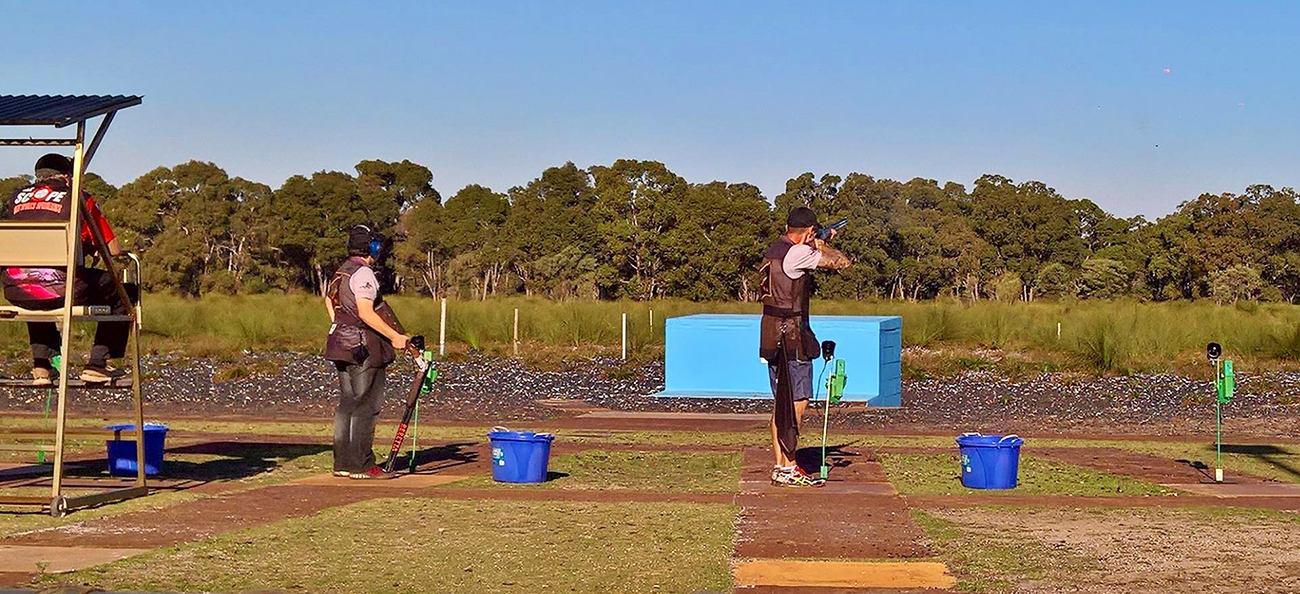
Down The Line
Down The Line (usually referred to as DTL) is the most common trap discipline.
The layout involves five shooting positions set 15 metres behind a single trap. The trap throws targets out to a distance of around 45 metres at a fixed height.
The targets are thrown within a 44 degree arc from the trap house (22 degrees either side of the centre line) but the angle of release randomly alters between each target.
The shooter on lane one will call for a target and attempt to shoot it. The full use of the gun is permitted so two shots are allowed. (Usually six shooters take part in a round) after one target has been shot.
The shooters all then circulate around to the next lane and continue until five targets have been taken at each of the five lanes.
A scorer is normally used for DTL to release the trap when a shooter calls “Pull”, to decide if the clay has been hit and to record the score. The Scorer allows the round to be shot at a fairly rapid pace and ensures each shooter shoots at the correct number of clays.
Although in theory you will only need 25 cartridges for a round of DTL you will inevitably use more than this due to several factors including the following. Usually each shooter is allowed a single practice bird at their first stand before the round commences and two shots are permitted at each target.
If the clay breaks when launched from a trap it is considered a “No Bird “and will be shot again. Shooters will occasionally shoot at the No Bird in error.
Skeet
A round of skeet consists of 25 targets shot on a semi-circular layout with two trap houses, the left being the high house, the right the low house. There are 8 shooting stations. One shot only may be fired at each target. Squads consist of 5 shooters, each takes his turn to shoot from the shooting station, and these are numbered from 1 to 8.
On stations 1,2, 6 and 7, after the shooter has shot the two single targets, one from each trap house a “double”, ie two targets are released simultaneously, one from each house, one shot is fired at each target. If at any time during a round a shooter misses a target the shooter reloads one cartridge and repeats the first target missed. If a shooter gets to station 8 low house without missing a target, the shooter repeats his last target to complete the round of 25 targets.
5 Stand Sporting Clays
5 Stand is a sub-discipline of sporting clay that utilises between 6 and 10 machines on a layout with 5 individual shooting stations spaced evenly apart. This discipline uses not only standard targets (110mm) but also uses midi (90mm), promatic 70 (70mm), super mini (60mm), battue (flat target with no dome), rabbit (hard edge rim target that rolls along ground).
Targets are thrown in a variety of singles and pairs to challenge any shooter. 5 Stand is highly interactive and fun for all shooters and spectators alike. Sporting clay and the many sub disciplines are predicted to become the biggest clay target shooting disciplines within the next 5 years.
Under ACTA rules we shoot ACTA 5 Stand Sporting, ACTA Sportrap (another form of 5 stand with larger distances between shooting stations) and ACTA English Sporting (All targets are presented as pairs).
Olympic Trap and Skeet
For those shooters looking for the ultimate challenge, the WAGC has 3 Olympic trap and skeet layouts, these targets travel faster and further and at wider angles than the standard trap targets.
